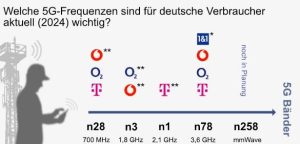What Is the Frequency Range of FR2 in 5G?
Exploring the High-Frequency Spectrum of FR2

The Frequency Range 2 (FR2) represents the higher frequency spectrum allocated for 5G networks, often referred to as the millimeter wave (mmWave) bands. This range covers frequencies from 24.25 GHz to 52.6 GHz, enabling significantly higher data rates and capacity compared to the lower frequency bands of FR1.
Key Characteristics of FR2
FR2 frequencies are characterized by their ability to carry vast amounts of data over short distances. This capability is crucial for high-density areas such as urban centers, stadiums, and other venues where large numbers of devices simultaneously demand high-speed internet access. The bands within this range include:
- n257 (26.5-29.5 GHz)
- n258 (24.25-27.5 GHz)
- n260 (37-40 GHz)
- n261 (27.5-28.35 GHz)
These bands are essential for applications that require extremely high throughput, such as virtual reality (VR), augmented reality (AR), and ultra-high-definition video streaming.
Advantages and Challenges of Using FR2
The main advantage of using FR2 is the unprecedented bandwidth it offers, which allows for faster data speeds and higher capacity. However, the higher frequencies also come with challenges, primarily related to signal range and penetration. Millimeter waves do not travel through obstacles as effectively as lower frequencies, which can lead to issues with signal attenuation and the need for line-of-sight connectivity.
Deployment Strategies
To overcome the propagation challenges associated with FR2, deployment strategies typically involve a dense array of small cells. These small cells are strategically placed to ensure coverage and capacity in targeted areas. This setup is crucial for maintaining a reliable connection, especially in environments where physical obstructions could disrupt the signal.
Global Utilization and Innovation
Different regions around the world are at various stages of deploying and utilizing FR2 bands. The utilization often depends on the technological maturity and specific urban needs of each region. Innovations in antenna design and adaptive beamforming technologies are critical in enhancing the performance and reliability of networks operating within the FR2 bands.
Impact on Future Technologies
The FR2 frequency range is pivotal for the future of wireless technology, enabling not just faster communication but also facilitating the development of new applications that require high data throughput. Its role is increasingly becoming critical as we step into an era dominated by data-driven technologies and interconnected devices. The strategic deployment of FR2 will continue to shape the capabilities and reach of 5G networks, pushing the boundaries of what is possible in the wireless communication landscape.